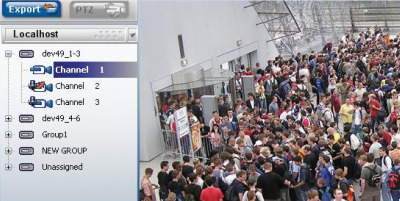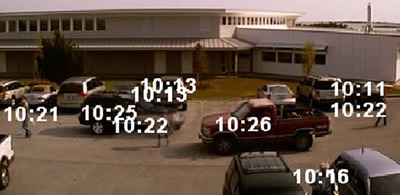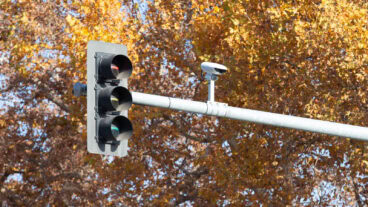Video surveillance systems have become a vital tool in enabling authorities to trace criminals and terrorists. Israel is one of the leading players in the field. ISRAEL21c brings you the top 10 video security technologies from Israel.
After the attempted bombing in New York’s Times Square just over a month ago, no one can be in any doubt of the significance of video surveillance systems. Within hours of the car being discovered, police had used surveillance camera footage in a nearby shop to identify a suspicious looking man seen near the vehicle.
In the London bombings in July 2005, where 52 were killed and 700 wounded, police officials were able to trace almost the entire journey of the four bombers as they prepared for the attacks, on dozens of surveillance cameras placed on the streets, and in railway and tube stations.
It’s not just terrorism, for crime too, police today turn immediately to surveillance cameras to try to discover what took place.
It’s no surprise that Israel is a world leader in this field. With its ongoing national security problems, the country relies heavily on advanced video security technology to keep the nation safe. Using expertise gleaned from the Israel Defense Force, Israeli companies have moved quickly into the field, responding first to the needs of the local market, and then using this as a base to access the rest of the world.
Today, Israeli video security companies provide some of the most advanced solutions in the world, selling to authorities all over Europe, the US and Asia. Their most common innovation – smart video surveillance systems that not only observe, but also analyze, alert and deliver results to security personnel. ISRAEL21c brings you the top 10.

One of the biggest problems facing security organizations is worker boredom. Monitoring large banks of monitors hour after hour has a debilitating effect on the people doing the observing, and that fatigue can be exploited by those bent on breaching security.
In addition to fatigue, continuity of observation is an important issue. When guards change shifts, continuity is lost, so that if they time it right, terrorists could place a bomb hidden in a bush next to an electrical plant or in the path of a security patrol. The bush would look as if it belonged there, and no one would realize anything was out of place until it was too late.
It’s to combat these two problems that MATE developed a video analytics system that can detect changes in surroundings and landscape, indicating whether anything has changed in a camera’s field of observation – such as if someone or something appears that hadn’t been there before. When such unauthorized changes are detected, the system alerts security personnel, pinpointing the problem and allowing them to deal efficiently with the situation before it gets out of hand.
MATE’s technology can be used for anything from detecting suspicious activities or behavior to counting people and cars, tracking objects, or even detecting tailgating or piggybacking through access-controlled doors.
Often, the devil is in the details – but most video surveillance systems are weak on picking up small details in images in real time. Security personnel watching a situation develop are often missing crucial information – such as whether a potential subject is holding a weapon. Arresting an individual before the time is right could compromise an investigation months in the making – or sow unnecessary and economically damaging panic.
To keep track of the details, security agencies can use a unique “panoramic telescope” developed by Yokneam-based Adaptive Imaging Technologies. The company, which won the Most Promising Startup award at last year’s Global Security Challenge, and has received a grant from the US Department of Defense, has developed a camera with a full gigapixel (1,000 megapixels) of raw resolution. With its telescopic lens, the camera can take in a very wide field, one which would usually require a much larger number of individual cameras.
Thanks to the innovative software that accompanies the camera, personnel can focus in on a target and receive a remarkably clear picture, de-emphasizing less critical parts of a scene. The result: Personnel can zoom in on the important details, giving authorities the information they need to deal with a crisis as effectively as possible.

After 9/11, installing and managing video surveillance systems became a priority for city, regional and national governments around the world. While many solutions were already on the market, managers and government officials needed a system they could deploy quickly and efficiently, that would also supply the necessary recording, analysis, and storage capabilities – and all this in a framework that would allow maximum flexibility and be able to integrate existing equipment.
Many managers, especially in the US and the UK, found that Israel’s Vigilant Systems could supply those solutions. Vigilant specializes in turnkey networked video management and recording solutions, streaming high quality images over robust wireless networks, and recording them for analysis.
Video from a wide variety of cameras is streamed to a single control room, where security personnel can keep an eye on a wide area, with the ability to focus in on detailed scenarios in high resolution.
Vigilant’s solutions have been installed in dozens of city centers and shopping malls in the US and the UK – where there are more video surveillance cameras per head than anywhere in the world, with managers saying that the systems have been integral elements in ensuring or restoring safety.
4. Briefcam

Cameras as we know are everywhere these days. But what happens to the footage they record? Often nothing happens, because there’s no one to sit and sift through the endless hours of video. It’s usually only after a major disaster or attack that officials check the video, hoping to get clues as to whom or what caused the problem.
Briefcam’s solution is its Video Synopsis product. Instead of watching the entire video, a viewer can see a synopsis – with the option of focusing in on objects or people of interest from a 24-hour period within a few minutes.
If viewers notice something odd in the behavior of an individual, they can focus in on that individual, and receive an index of all his or her movements in the entire range of footage. With Briefcam VS, security personnel have a more efficient way to watch and analyze footage, making it more likely that they will catch problems before they occur.
5. Sea-Eye Underwater Technology
Not all dangers are visible to the roving camera’s eye; some are hidden away, underwater. Israel has experienced several attacks at the hands of scuba-diving terrorists, and underwater pipes and other installations may also be at risk. Cameras would certainly be useful as aids in underwater security, but the limitations on video in underwater situations – transmission of very low-resolution pictures via cameras that have to be tethered to a ship console – make underwater video impractical for security purposes
That is, unless you’re using the underwater video system perfected by Sea-Eye, which overcomes previous limitations by combining new advances in signal processing and video compression.
A featured part of the system is a modem that allows data transmission at rates that are much more robust than in most other systems. In addition, Sea-Eye has developed algorithms to cope with underwater signal transmission problems such as multi-path reflection and Doppler effects, enabling streaming video or voice broadcasting to proceed unimpeded. The result – clearer underwater pictures with more detail – granting security services better tools to protect underwater installations.
6. AgentVI
Large facilities like airports, shopping malls, or stadiums are nowadays equipped with cameras that allow security personnel to view nearly every square inch of the facility. But what is it that personnel are seeing? How can they differentiate between individuals or groups out for good clean fun, and those with crime – or terrorism – on their minds?
One innovative way is by using the video analytics system developed by Agent VI (formerly Aspectus), with research facilities in Rosh Ha’ayin, in central Israel. The company’s VI-System compares video to a database of behavior patterns. When a pattern is detected that indicates trouble, an alarm is sounded, alerting personnel.
The alarms could be set off by images ranging from someone dropping a gym bag in the corner of a busy downtown intersection, to someone reaching behind an unattended jewelry counter in a department store. Those guys are likely up to no good – and with Agent VI’s technology, the chances that security personnel can nip a crime or attack in the bud are greatly improved.

Some of the ‘softest’, most vulnerable, targets for terrorists are the ones where they can operate uninterrupted and unobserved. Take a reservoir, for example – a body of water that sits relatively unattended and unprotected (except for a perimeter fence), but upon which millions of people depend. Even placing a battalion of soldiers there wouldn’t necessarily be sufficient to protect such a large facility – not that governments can afford to allocate those kinds of resources anyway.
One solution that has proven successful has been perimeter detection, a specialty of Magal Systems, based in Yehud in central Israel.
Magal is one of the largest outdoor, major-installation security companies in the world, with offices in dozens of countries, which claims 40 percent of the worldwide market for Perimeter Intrusion Detection Systems.
Using a wide range of tools – from video cameras to lasers to microwave sensors and more – all controlled by automated software that can instantly alert those in charge, Magal is keeping safe thousands of sensitive sites and tens of millions of people.
8. NICE Systems

To be effective, a surveillance system has to be nimble. At large facilities, security personnel must watch out for numerous threats, and any system that can ferret out the unnecessary information, delivering only the required data, is most welcome.
That’s one of the strengths of NICE System’s NiceVision technology. Along with a robust network that can deliver high-quality images and simplified, unified management capabilities, NiceVision also features distributed video analysis, which streams video only when an event is detected. This ensures that security personnel see what they need to see, while allowing them the flexibility of dealing with tasks other than observing video feeds.
Currently, NiceVision solutions record, analyze and manage video data from over 200,000 cameras deployed around the world, at airports, highways, railways, hotels, cruise lines, public facilities, schools and many other sites.
9. Camero
While security cameras – both stationary and roving – are useful in observing open areas and perimeters, they are far less useful in urban settings. Buildings and other large objects abound, providing terrorists or criminals with the cover they seek to avoid authorities – and stay out of view of cameras.
Camero, with R&D facilities in central Israel in Kfar Netter, has developed a unique camera that can ‘see’ through walls, that denies the bad guys the advantages provided by urban environments.
The Camero Xaver system uses 3D image reconstruction algorithms in conjunction with sophisticated, patented signal processing techniques and a unique proprietary Ultra-Wideband (UWB) sensor design with extremely high bandwidth and a very high dynamic range.
The result is an ability to generate 3D images of objects concealed by solid barriers such as walls, made from a variety of known materials including cement, plaster, bricks, concrete and wood. With the system set to receive FCC (Federal Communications Commission in the US) certification this year, Camero will be ready to install systems throughout the US in the coming months.
10. Bynet
In an enclosed area, cameras using some of the technologies outlined above can be used to effectively stop and catch suspects. But what if the suspect gets into a vehicle? At that point, cameras can no longer track the suspect, and important information that could help defuse the situation is lost.
That problem can be countered with the high-resolution mobile video surveillance system from Bynet, Israel’s largest hardware, software, and technology integrator. Along with advances in video surveillance, Bynet partners have developed technology that enables the company to offer a unique solution for border patrols, police and other law enforcement agents.
The central feature of the technology is a communication system capable of transmitting live, real-time video, data and voice communications via a single broadband connection, using a fast, secure, private network.
The key to the system is the high-speed wireless network, which allows fast transmission of high-resolution video and audio without any effort required on the part of the driver. The vehicle continues on its rounds or pursues a suspect, and the camera focuses, with an individual in the control center able to enhance the picture to see inside a vehicle even hundreds of meters away.
Add to that Bynet’s unique video correction system, and security and law enforcement officials won’t miss a move suspects make.












